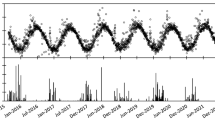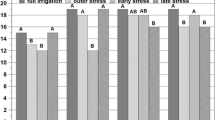Abstract.
When subsurface irrigation sources are lacking, storage of precipitation in farm ponds and lakes may provide a source for irrigation, but the amount of water available may be limited. Deficit irrigation at selected growth stages may help avoid crop stress at critical times. The objective of this study was to determine the effect of timing of a single irrigation on soybean cultivars planted at two dates. The experiment was conducted from 1987 to 1990 on a Parsons silt loam (fine, mixed, thermic Mollic Albaqualf) near Parsons, Kansas. The experiment was designed as a split-plot with the eight whole plots being a factorial arrangement of irrigation treatments and planting dates and subplots were soybean [Glycine max (L.) Merr.] cultivars. The four irrigation treatments were: (1) no irrigation, (2) 2.5 cm at growth stage R1 to R2 (beginning to full bloom), (3) 2.5 cm at R4 (full pod), and (4) 2.5 cm at R6 (full seed). The two planting dates were early and late June. The three, maturity group IV, soybean cultivars were Crawford, Douglas, and Sparks. In the less stressful years, 1987 and 1989, yield was unaffected by irrigation when soybean cultivars were planted in early June, but irrigation increased yield of late-June-planted soybean by 0.4 Mg ha–1 or more. In 1988 and 1990, climatic conditions were dry and hot. This resulted in low yields, but regardless of planting date, soybean responded to irrigation applied at any growth stage in 1988 and at R6 in 1990. Yield increases from irrigation appear to be more related to increasing seeds per plant than seed weight. Selection of the timing of a single irrigation between growth stages R1, R4, and R6 may not result in large yield differences because all increased the number of seeds per plant. Irrigation at R6 also increased average seed weight. With typical weather conditions in the mid-latitude section of the eastern Great Plains, soybean planted in late June are more likely to benefit from a single irrigation than those planted in early June.
Similar content being viewed by others
Author information
Authors and Affiliations
Additional information
Electronic Publication
Rights and permissions
About this article
Cite this article
Sweeney, D.W., Granade, G.V. Effect of a single irrigation at different reproductive growth stages on soybean planted in early and late June. Irrig Sci 21, 69–73 (2002). https://doi.org/10.1007/s00271-001-0051-x
Received:
Issue Date:
DOI: https://doi.org/10.1007/s00271-001-0051-x




